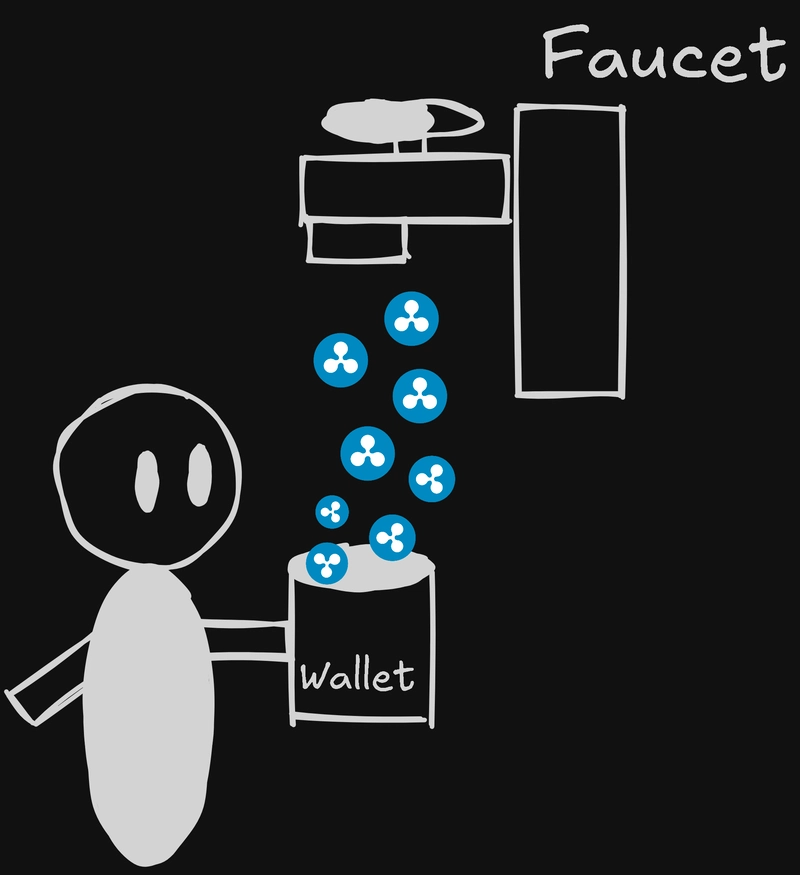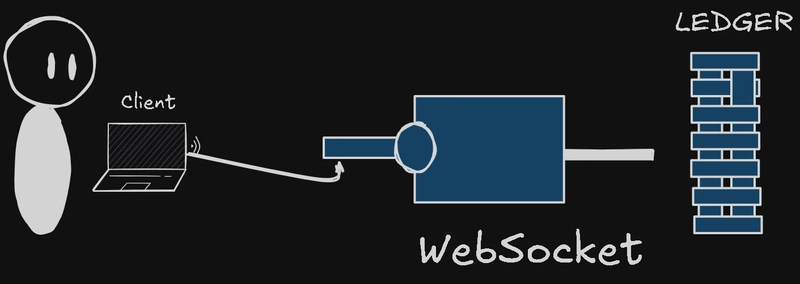This content originally appeared on DEV Community and was authored by Alan Buenrostro
Installing The XRPL Library
This tutorial uses the xrpl library installed via npm
npm install xrpl
Baby Steps.
In order to make meaningful interactions with the xrp ledger , such as currency transactions, wallet creation, etc. We must first connect to the server.
We do so, by:
- importing the
ClientObject from thexrpllibrary - Instantiating the
Clientobject with the xrplwebsocketserver address. - making a connection
using connect() - Disconnecting when the interaction is done.
//ES6 Imports
import {Client} from 'xrpl'
async function connectToLedger(){
//Instantiate the object with xrpl address as an argument and store its reference.
const client = new Client('wss://s.altnet.rippletest.net:51233/')
//Connect Via the connect function
await client.connect()
console.log(await client.connection)
//insert other code down here
//Bla Bla Bla
client.disconnect();
}
connectToLedger()
A brief breakdown xrp test network : wss://s.altnet.rippletest.net:51233/1
Faucets

In the realm of xrp, there exist a set of developer tools called Faucets aka test nets.
Faucets, Replicate the functionality of the mainet allowing you to test ledger interactions on a testing environment, and it also provides a websocket for fulfilling these interactions. These interactions include but are not limited to wallet creation, and token transactions.
Learn more: https://xrpl.org/resources/dev-tools/xrp-faucets
Why Dov We Need Faucets?
Some mainet interactions requires a small amount of xrp for ex; transactions, fund transfers, and tokenization, The benefit of a faucet really starts to shine when it comes to testing transactions and other important blockchain functionality without risking real xrp.
Wallet Creation
Now lets create a wallet and provide some funds.
import {Client} from 'xrpl'
async function connectToLedger(){
//Instantiate the object with xrpl address as an argument and store its reference.
const client = new Client('wss://s.altnet.rippletest.net:51233/')
//Connect Via the connect function
await client.connect()
//Instantiating A wallet with fundWallet and storing its reference.
let testFund = await client.fundWallet();
//Waiting for promise and storing referennce of the wallet property
let wallet = (await testFund).wallet
//Waiting for promise and storing the wallet balance property
let balance = (await testFund).balance
console.log(`Wallet Public Key : ${wallet.publicKey} \nWallet Balance : ${balance}` )
client.disconnect();
}
connectToLedger()
Code Breakdown
fundWallet()
on line 10 we call the asynchronous fundWallet method from our previous client object.
this function returns an object containing a Wallet object, and within the Wallet object there are details such as its publicKey andprivateKey and seed phrase.
Alongside the Wallet object we have its balance.
In essence the function:
generates a new wallet.
-
Initiates a faucet transaction that sends 100 test XRP to the wallet’s public address via a WebSocket connection. This triggers a sequence of interactions between operation and issuer accounts on the test network.
Why
FundWallet?As we mentioned earlier, this is a testing environment, so we are able to utilize functions such as
fundWalletto easily retrieve a dispensable wallet with dispensable funds, however you are not allowed to usefundWallet()on themainet, you need to generate a wallet and send it funds via an external wallet with xrp or aDigital Exchange. See [[#Generating A wallet on the main-net.]] for more details.
Ex
{
wallet: Wallet {
publicKey: 'kgphikthpotpruktf325235rpkopkwpokgwopenr12359322f',
privateKey: 'idjfi0wufj14faafaaffff110124812401gsafawfwafa4',
classicAddress: 'idjfi0wufj14afafawawfafaafawfawfaw95329595f',
seed: 'afiafjawifjawoifaw'
},
balance: 100
}
Querying data from a ledger.
client.request()
This method, is used for querying various types of ledger data, Afterall a ledger is a data structure and thus can be used as database. This method accepts a object map for query configuration. The current configuration we are using is:
let onChainData= await client.request({
command:"account_info", //The type of data we want to querry
account:wallet.address, // The specific account or adress we want to querry
ledger_index:"validated", // Most recently validated ledger index
});
console.log(`Balance In Drops : ${onChainData.result.account_data.Balance}`)
| Config Key | Description |
|---|---|
command |
The query type |
account |
The account we desire to query in this context were using the address of the recently generated wallet |
ledger_index |
A specific ledger selector - in this context were selecting the most recently validated ledger index containing information surrounding this address. |
Once the request is fulfilled it should return an object similar to this one:
{
api_version: 2,
id: 6,
result: {
account_data: {
Account: 'fafawfawwfajifjawifawjfawf',
Balance: '100000000',
//.... Ledger Data
},
account_flags: {
//.... Ledger Data
//.... Ledger Data
},
ledger_hash: 'faiwhfa9w0fhaw0f9ahf90awhf90awfhaw90fhawf0aw9ha9fhaw',
ledger_index: 67999825,
validated: true
},
type: 'response'
}
Final Source Code
import {Client} from 'xrpl'
async function connectToLedger(){
//Instantiate the object with xrpl address as an argument and store its reference.
const client = new Client('wss://s.altnet.rippletest.net:51233/')
//Connect Via the connect function
await client.connect()
//Instantiating A wallet with fundWallet and storing its reference.
let testFund = await client.fundWallet();
//Waiting for promise and storing the wallet property
let wallet = (await testFund).wallet
//Waiting for promise and storing the wallet balance property
let balance = (await testFund).balance
console.log(`Wallet Public Key : ${wallet.publicKey} \nWallet Balance : ${balance}` )
//Configuring querry via object
let onChainData= await client.request({
command:"account_info", //The type of data we want to querry
account:wallet.address, // The specific account or adress we want to querry
ledger_index:"validated", // Most recently validated ledger index
});
console.log(`Balance In Drops : ${onChainData.result.account_data.Balance}`)
client.disconnect(); // A gracefull disconnect
}
connectToLedger()
Generating a wallet and account on the main-net.
You can generate and receive its private and public key but it or any related data wont be on the ledger until a transaction its made to the wallet address.
Generating A Wallet
import {Wallet} from xrpl
let wallet = Wallet.generate();
Generate a wallet from seed
If you want to generate a wallet address based on a seed phrase:
import {Wallet} from xrpl
let wallet = Wallet.fromSeed("AFNAK9310913JFSAANFJFn")
This content originally appeared on DEV Community and was authored by Alan Buenrostro
Alan Buenrostro | Sciencx (2025-04-22T02:34:45+00:00) 🚀 Diving into the XRP Ledger with JavaScript. Retrieved from https://www.scien.cx/2025/04/22/%f0%9f%9a%80-diving-into-the-xrp-ledger-with-javascript/
Please log in to upload a file.
There are no updates yet.
Click the Upload button above to add an update.

